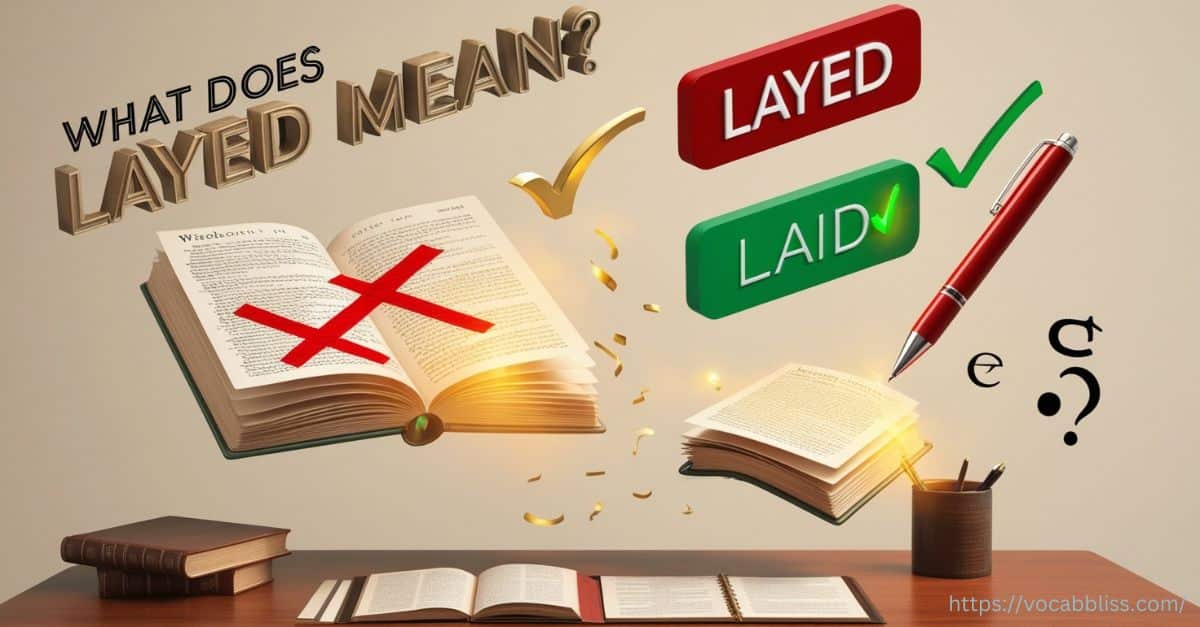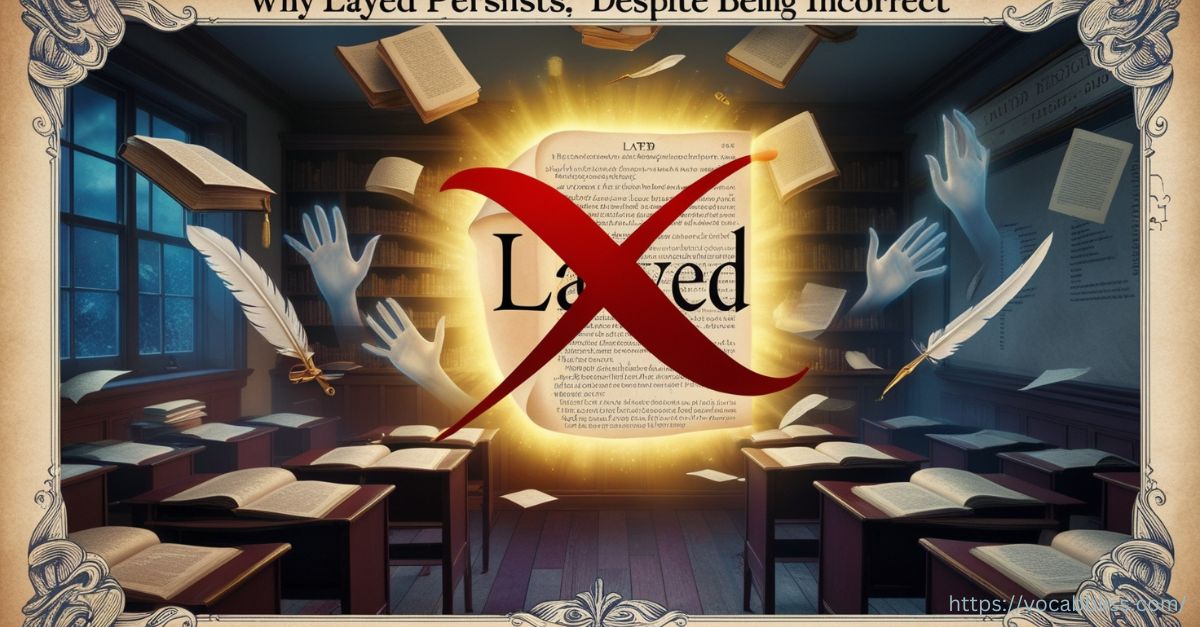If you’ve ever hesitated while writing, unsure whether to use “layed or laid”, you’re not alone. This common grammar conundrum has left many scratching their heads. The good news? By the end of this article, you’ll know exactly which word to use in every situation, and you’ll never mix up “laid vs layed” again.
Let’s dive in and clarify everything about “laid or layed”, including rules, examples, and even some surprising history!
Quick Summary
In short, “laid” is the correct past tense of the verb “lay,” used when describing placing or setting something down. It follows English grammar rules and requires a direct object (e.g., “She laid the keys on the table”). On the other hand, “layed” is an incorrect form and should be avoided. While “layed” may appear in informal contexts or due to confusion with regular verbs, it’s important to stick with “laid” to maintain grammatical accuracy. Just remember: Laid = Lay + Object, and you’ll never get it wrong again.
Explore further: Skull or Scull: Exploring the Critical Differences
Clear the Confusion Between Layed or Laid
Why It Matters
Using the correct word in writing and speech isn’t just about following grammar rules—it’s about clarity and credibility. Imagine you’re reading a professional document, and you spot a glaring error like “layed.” It can distract readers and even undermine your message. Using proper words ensures that you communicate in a polished, professional, and easy-to-understand way.
Moreover, “layed vs laid” confusion often appears in everyday language, making it essential to get it right whether you’re writing an email, a report, or even a social media post. The right choice shows you value precision and helps you avoid common pitfalls that might confuse your audience.
Quick Clarification
Here’s the short answer: laid is always correct. It’s the past tense and past participle of the verb “lay.” On the other hand, “layed” is not a correct word in modern English.
What Does Layed Mean?

Many people mistakenly think “layed” is the past tense of “lay,” but this assumption is incorrect. In modern English, layed is not a proper word.People consider it a misspelling of “laid,” which is the standard past tense and past participle of “lay.”
Here’s why:
- English verbs follow specific rules for conjugation. While “lay” becomes “laid” in the past tense, “layed” does not fit any recognized grammatical pattern in contemporary English.
Example of incorrect usage:
- The workers layed the bricks yesterday.
Correct version:
- The workers laid the bricks yesterday.
Historical Context and Obsolete Usage
Although “layed” is incorrect today, it wasn’t always so. In Middle English, “layed” occasionally appeared in writings, functioning as an alternative spelling of “laid.” Over time, people established standardized spelling rules, and they made “laid” the accepted form.
Historical examples:
- In some older texts, you might find phrases like “the stones laid in place.”.” These instances reflect the language’s evolution rather than an error.
In modern English, people consider these older uses archaic. Writers should stick with “laid” to adhere to current grammar rules.
Common Misconceptions About Layed
Why do so many people still use “layed”, even though it’s incorrect? Here are some common reasons:
- Phonetic Similarity
- “Layed” and “laid” sound almost identical when spoken, leading to spelling errors.
- Lack of Awareness
- Non-native speakers or those unfamiliar with English grammar rules often default to “layed” because it seems logical.
- Typos and Informality
- In casual writing, like text messages or social media, “layed” often slips through as an error.
Examples of misuse laid out or layed out
- “The groundwork was layed last week.”
- “They layed out the picnic blanket.”
Why they’re wrong:
- The correct form is “laid,” as in “the groundwork was laid” or “they laid out the blanket.”
What Does Laid Mean?
Definition of Laid
The word “laid” is the correct past tense and past participle of the verb “lay.” We use it when describing the act of putting something down, arranging it, or setting it in place.Unlike “layed,” which is grammatically incorrect, “laid” adheres to all modern English grammar rules.
For example:
- The builder laid the bricks with precision.
- She laid her keys on the counter before heading out.
Grammar Rules Governing Laid
To fully understand “laid,” it’s important to see how it operates within English grammar:
- Verb Conjugation
- The base form is “lay,” which means to place something down.
- The past tense and past participle form is always “laid.”
- Transitive Verb Usage
- “Lay” (and its past form “laid”) always follows a direct object, meaning something acts upon it.
- Example: She laid the book (direct object) on the table.
- Not to Be Confused with “Lie”
- “Lay” requires a direct object, while “lie” (and its past tense “lay”) does not.
- Example:
- Correct: She laid the baby down for a nap.
- Incorrect: She lay the baby down.
Everyday Examples Using Laid
To help you confidently use “laid” in your writing and speech, here are some practical examples:
- The hens laid eggs in the barn early this morning.
- He laid the groundwork for the project before the team arrived.
- The carpet was laid out neatly in the living room.
- The foundation was laid, not “layed,” before construction began.
- She carefully laid out the clothes for her trip.

In each example, note how “laid” follows the grammatical rule of requiring a direct object. Whether you’re discussing physical placement (e.g., “laid eggs”) or a metaphorical action (e.g., “laid the groundwork”), “laid” is always the correct choice.
Using these examples in context will make it easier to remember when to use “laid” and avoid the common pitfalls of confusing it with “layed.”
Layed vs Laid: Key Differences
Contextual Differences
The distinction between “layed or laid” largely depends on context—formal, informal, or historical. Here’s how they differ:
- Formal Contexts
- In formal writing, such as academic papers, business communications, or professional settings, “laid” is the only acceptable term.
- Example:
- “The foundation was laid with careful planning.”
- “The foundation was layed with careful planning.”
- Informal Contexts
- In casual conversations, text messages, or social media posts, “layed” occasionally appears due to ignorance of proper grammar. People often forgive it in informal settings, even though it’s not technically correct.
- Example:
- “I just layed the table for dinner!” (Incorrect but common in casual text.)
- “I just laid the table for dinner!” (Correct.)
- Historical Contexts
- As noted earlier, “layed” was an alternate spelling in older English texts. While obsolete today, historical documents or literature may include “layed.” Recognizing this usage is important for interpreting older works but doesn’t justify its use in modern writing.
Why Layed Persists Despite Being Incorrect

Even though “layed” is grammatically incorrect, it continues to appear for several reasons:
- Phonetic Confusion
- The similar pronunciation of “layed or laid” causes many people to spell them interchangeably. Without checking grammar rules, “layed” feels intuitive.
- Digital Communication Habits
- In today’s fast-paced world, typos and informal spellings are common in texts, emails, and social media. For example:
- “I layed out all the plans last night!”
- Here, speed and convenience often override correctness.
- In today’s fast-paced world, typos and informal spellings are common in texts, emails, and social media. For example:
- Autocorrect Errors
- Some devices mistakenly suggest “layed” as an alternative, reinforcing its misuse.
- Misunderstanding Grammar Rules
- Non-native English speakers and even some native speakers might not know the conjugation rules for “lay.” They assume “layed” fits the pattern of regular verbs like “played” or “stayed.”
- Historical Influence
- The outdated use of “layed” in older texts can mislead people into thinking it’s acceptable today.
- Overlooked Errors in Informal Writing
- In informal settings, people often don’t proofread their messages, allowing “layed” to persist.
Visual Comparison of Layed vs Laid
Table of Side-by-Side Comparison
| Feature | Layed | Laid |
|---|---|---|
| Correct Usage | ❌ Not correct in modern English | ✅ Grammatically correct and standard |
| Part of Speech | Not applicable | Verb (Past Tense and Past Participle of “Lay”) |
| Examples | Not standard | “She laid the book on the table.” |
| Historical Use | Archaic and obsolete | Current and widely accepted |
| Grammar Rules | Doesn’t conform to rules | Follows proper verb conjugation rules |
This table provides a clear overview of the “laid vs layed” debate, highlighting why “laid” is the correct choice in modern English. Understanding these distinctions will help you avoid common grammar mistakes and improve your writing.
Key Takeaway
Whenever you’re unsure whether to use “layed or laid,” remember that only “laid” adheres to proper English grammar. While “layed” might seem phonetically correct, it is not acceptable in formal or casual writing. By following this rule, your communication will remain professional and precise.
Everyday Usage Examples of Laid
Using “laid” correctly in sentences is essential for clear communication. Here are examples that showcase proper usage in both formal and casual contexts, highlighting everyday scenarios where people commonly apply the word.
Formal Usage Examples
- Setting Foundations
- The engineers carefully laid the foundation for the new bridge.
- The team laid out a solid plan before construction began.
- Professional Contexts
- She laid the groundwork for the company’s expansion strategy.
- The documents were laid out neatly for the board meeting.
- Educational or Instructional Writing
- The principles of the theory were laid out in the first chapter.
- The teacher laid the framework for the students’ group projects.
Casual Usage Examples
- Making a Bed
- After cleaning the room, she laid the sheets neatly on the bed.
- Setting a Table
- He laid the plates and utensils on the table before dinner.
- She had laid out sandwiches, drinks, and snacks, and the picnic was ready.
- Construction and Repairs
- The mason laid the bricks in perfect alignment.
- The workers laid the tiles in the kitchen this morning.
- Daily Routines
- She laid her phone on the counter and went to grab a drink.
- The kids laid their backpacks in the hallway after school.
- Other Common Scenarios
- The hen laid eggs in the coop early this morning.
- He laid his tools aside after finishing the project.
Conclusion
To sum up, the difference between laid or layed out boils down to correctness and usage. While “laid” is the proper past tense of “lay” and adheres to English grammar rules, “layed” is simply a misspelling that persists due to phonetic confusion or lack of knowledge.
Here’s what to remember:
- “Laid” always follows a direct object (e.g., “She laid the book on the table”).
- “Modern English does not consider “layed” correct.”
A Memorable Takeaway
To ensure you always use laid correctly, remember this simple trick:
- “Laid” = Lay + Object (Something was placed down).
- Think of “laid” as the correctly laid brick in your grammar foundation.
FAQs About Layed vs Laid
- Is Layed a Correct Word?
No, layed is not a correct word in modern grammar. - How to Use Laid in a Sentence?
Here’s an example: “She laid the groundwork for the new policy.” - Laid vs Layed Past Tense: Which is Right?
“Laid” is correct as the past tense of “lay.” - When to Use Laid in Writing?
Use “laid” whenever you’re describing an action of placing something. Example: “The hens laid eggs in the barn.” - Common Mistakes with Laid and Layed
Confusing the spelling: “laid” is always correct.
Overthinking: Stick with grammar rules, and you won’t go wrong! - Is It “Laid in Bed” or “Layed in Bed”?
The correct phrase is “laid in bed.” Example: She laid in bed all day feeling unwell. - What Does “Layed” Mean in Modern English?
In modern English, “layed” is considered a misspelling and should not be used. - Is It Correct to Say “Layed on the Floor”?
No, the correct phrase is “laid on the floor.” Example: The rug was laid on the floor carefully. - Is It “Laid Snow” or “Layed Snow”?
The proper expression is “laid snow.” Example: Fresh snow was laid across the field by the storm.
By mastering these tips, you’ll never confuse “laid versus layed” again.
Continue reading:
- Hayday or Heyday: Which Term is Correct to Use?
- In Person or In-Person: When and Which Should You Use?
- Allude vs Elude: How and where to Use
- Brake vs Break: The Ultimate Word Battle

Jorge Phillips is an experienced blogger who writes for Vocab Bliss, sharing his passion for the English language. With a knack for simplifying complex grammar rules and a focus on commonly confused words, Jorge helps readers navigate the nuances of English with ease. His insights aim to make learning engaging and practical.







